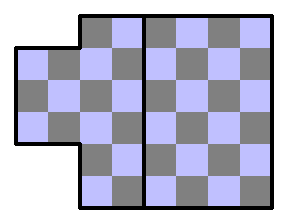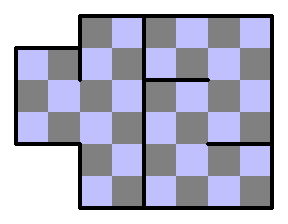A Silly 42-Squares Board
Jared McComb

|
This is a silly board I came up with while I was
trying to find creative boards for entries for the 42-Squares Contest.
But what's so silly about it? It's just a 6 by 6 square with a little rectangle attached to it. I'm glad you asked. First, let me outline the board. |

|
So it's got a line around it. I still don't get it. That's because I'm not done with it. Let me draw another line down the middle. |

|
So now it's a 4 by 6 rectangle next to a funny-shaped piece. So?
Did I say I was done yet? Let me add a few more lines. |

|
It's a snake and a cactus.
No, no, no! Look at the outlines by themselves. Oh, I get it now. It's the number 42. Cute. But not silly. |
Sheesh! Everyone's a critic.
Sorry. So did you come up with a chess variant for it, or is it just here for it's own sake?
As a matter of fact, I did. It's a unirexal variant.
White takes the bottom two rows of the 6 by 6 square, and Black, the top two rows. Each player has six Pawns along their second row, and behind them, in any order they wish, they place two Rooks, two Bishops, and two Knights. A King is placed in the little rectangle to the left, in the outermost corner on White's side. The King may not move outside this part of the board (called the annex), but may move to any other square in it during any turn. Other pieces may not enter the annex. Pawns do not promote, and there is no en passant. On their turn, a player may move the King, and then move one of their pieces. If a player checks the King, it must be moved by the other player. To checkmate it, a player must attack enough squares in the annex such that the opponent can't move the King out of check by either player.
Interesting. Now what?
Now why don't you stop talking in italics?
But I like italics!
Oh, fine. Send me an email at
tell me about a better CV for this board. (No italics please!)Written by Jared B. McComb. HTML Conversion by Peter Aronson.
WWW page created: March 8th, 2002.
